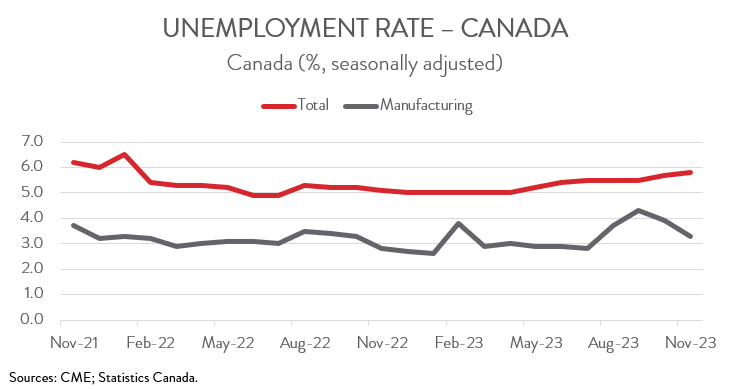Labour Market Trends
Labour Market Trends
November 2023
Economy Adds 25,000 Jobs in November, Driven by Strong Gains in Manufacturing
HIGHLIGHTS
- Employment rose by 24,900 (+0.1%) in November, up for the fourth consecutive month.
- The increase spanned 10 of 16 industries, led by manufacturing and construction.
- Manufacturing employment rose by 28,400 (+1.6%) last month, more than offsetting a decline of 18,800 (-1.0%) in October.
- The headline unemployment rate ticked up 0.1 percentage points to 5.8% in November, while the jobless rate in manufacturing fell 0.6 percentage points to 3.3%.
- Year-over-year wage growth in the manufacturing sector decelerated from 6.9% in October to a still brisk 5.6% in November.
- Total employment was up in 6 of 10 provinces, with New Brunswick posting the most impressive gain and PEI recording the steepest loss. The job growth in manufacturing was concentrated in BC.
- Although low by historical standards, Canada’s unemployment rate is up 0.8 percentage points since April, a level of increase that is typically associated with recessions.
LABOUR MARKET POSTS MODEST GAIN
Employment rose by 24,900 (+0.1%) in November, up for the fourth consecutive month. The underlying details of the report were mixed. While overall growth was driven by full-time jobs and private sector employment, total hours worked fell for the second time in three months, the latter of which indicates that the Canadian economy continues to limp along.

As has been the case in recent months, employment rose but not quickly enough to keep pace with Canada’s rapid population growth, leading to another uptick in the unemployment rate. Although low by historical standards, the unemployment rate is up 0.8 percentage points since April, a level of increase that is typically associated with recessions.
MANUFACTURING EMPLOYMENT SEES BIG INCREASE
Manufacturing employment rose by 28,400 (+1.6%) last month, more than offsetting a decline of 18,800 (-1.0%) in October. With this gain, manufacturers have added 43,200 jobs over the last 12 months. Accordingly, employment in the sector stood at 1.83 million in November, exceeding the 1.8-million mark for the seventh consecutive month, a level not seen since late 2018. Looking ahead, however, the manufacturing sector continues to face numerous headwinds that will likely limit job creation over the near term, including ongoing workforce challenges, high interest rates, and soft global demand.
Elsewhere, employment was up in 9 of the remaining 15 major industries, with construction (+16,200) joining the manufacturing sector as one of the growth drivers in November. These gains were partly offset by pullbacks in wholesale and retail trade (-26,900) and finance, insurance and real estate (-18,400).
HEADLINE UNEMPLOYMENT RATE TICKS UP TO 5.8%
The headline unemployment rate ticked up 0.1 percentage points to 5.8% in November, bringing the cumulative increase since April 2023 to 0.8 percentage points. Bucking the overall trend, the jobless rate in manufacturing fell 0.6 percentage points to 3.3%, a four-month low.

WAGE GROWTH IN MANUFACTURING REMAINS BRISK
Headline wage growth remained steady at 4.8% year-over-year in November, well above the historical average of 3.0%. The manufacturing sector continues to experience much more intense wage pressures than that of the overall economy. On a year-over-year basis, average hourly earnings in the sector decelerated from 6.9% in October to a still brisk 5.6% in November. The average factory worker earned $33.96 an hour in November 2023, up from $32.16 an hour in November 2022.

JOB GAINS IN MANUFACTURING CONCENTRATED IN BC
Regionally, the increase in total employment spanned 6 of 10 provinces. The biggest absolute gain was recorded in BC (+9,000), while the largest proportional increase was observed in New Brunswick (+2,400). New Brunswick’s economy has created a solid 15,000 jobs over the past 12 months. On the negative side, employment in PEI declined by 1,300 in November, down for the second month in a row.
In the manufacturing sector, employment was up in seven provinces in November, with the bulk of gains taking place in BC (+18,800). In proportional terms, a meaningful increase was also observed in Newfoundland and Labrador (+1,900). Taking a longer-term view, manufacturers in Ontario (+18,800) have created the most jobs over the past year, while manufacturers in Quebec (-5,300) have shed the most workers.
